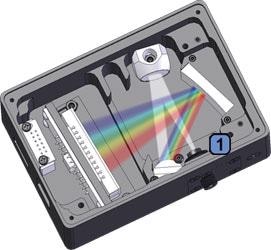Sponsored by m-oemDec 2 2016
A spectrometer is an imaging system used to map plurality of monochromatic images of the entrance slit onto the detector plane. This slit determines the amount of light (photon flux) that enters the optical bench and is essential for the performance of spectrometers. It is also a driving force in the determination of spectral resolution. Other factors are groove frequency, detector pixel size, and grating.

The installed slit will ultimately determine the throughput and optical resolution of a spectrometer. Light that enters the optical bench of a spectrometer through lens or a fiber is focused onto the pre-mounted and aligned slit. The angle of the light that enters the optical bench is controlled by the slit.
Slit widths are available in several different sizes from 5 µm to as big as 800 µm with a 1 mm (standard) to 2 mm height. As slits are aligned and permanently mounted into a spectrometer and should only be changed by a trained technician, it is essential to choose the appropriate slit for an application.
The most commonly used slits in spectrometers are 10, 25, 50, 100 and 200 µm. In systems that use optical fibers for input light coupling, a fiber bundle matched with the shape of the entrance slit (stacked fiber) may be used to increase the system throughput and coupling efficiency.
Technical Details
The function of the entrance slit is to define a clear-cut object for the optical bench. One of the key factors that it impacts the throughput of the spectrograph is the size (height (Hs) and width (Ws)). The image width of the entrance slit is an important factor in finding the spectral resolution of the spectrometer when it is greater than the pixel width of the detector array. An appropriate entrance slit width should be selected to balance the resolution and throughput of a system.
The image width of the entrance slit (Wi) can be estimated as:
Wi = (M2×Ws2+Wo2) 1/2
Where M is the magnification of the optical bench that is set by the ratio of the focal length of the focusing mirror (lens) to the collimating mirror (lens); Wo is the image broadening caused by the optical bench; and Ws is the width of the entrance slit. Wo is on the order of a few tens of µm for a CZ optical bench.
So, reducing the width of the entrance slit below this value will not significantly improve the resolution of the system. The axial transmissive optical bench offers a considerably smaller Wo and so can achieve a considerably higher spectral resolution. The pixel width (Wp ) of the array detector sets another limit on spectral resolution. Reducing Wi below Wp will not help increase the resolution of the spectrometer.
If the resolution requirement is satisfied, the slit width should be as wide as possible to enhance the throughput of the spectrograph.

This information has been sourced, reviewed and adapted from materials provided by B&W Tek.
For more information on this source, please visit B&W Tek.